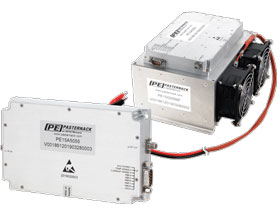

A Class AB amplifier is a highly used amplifier design for high-power RF applications, as well as other applications that require high power gain with minimal signal distortion.
The main benefit is that Class AB amplifiers are biased so that the output current flows for less than one full cycle of the input waveform, but for more than a half cycle of the waveform. An AB amplifier design allows for the multiple switching transistors in the complementary output stage to conduct an opposite half-cycle of the input waveform prior to combination at load.
This design results in minimised crossover distortion, in contrast to that of the Class B amplifier design, as both output transistors conduct for a short period of time each cycle during the zero crossover period. Hence, AB amplifiers have a conduction angle greater than 180 degrees and smaller than 360 degrees.
The benefit of this design is a much more efficient amplifier than a Class A amplifier, but which delivers better signal quality than a Class B amplifier, albeit less efficiently. With good bias control, the distortion associated with partial conduction amplifiers can be minimised in Class AB configurations.
In the case of RF amplification, Class AB amplifiers with excellent efficiency can be designed that have extremely wide bandwidths, high gain and high saturated output power levels. Class AB high-power amplifiers (HPAs) that reach 18 GHz are available with saturated power output levels reaching 10 Watts to 200 Watts. Depending on the technology, available Class AB HPAs can reach power added efficiency (PAE) of 40%.
Power level gains for these types of amplifiers range from 37 dB to 53 dB. Additionally, these amplifiers also often feature DC bias control, which is sometimes TTL logic controlled. Added features include current and temperature sensing functions for better bias compensation and monitoring, as well as heatsink enclosures with the ability to add cooling fans for better thermal management.
There are several common semiconductor technologies used to fabricate Class AB HPAs: vertically diffused metal oxide semiconductor (VDMOS), laterally diffused metal oxide semiconductor (LDMOS) and gallium nitride (GaN) transistors.
Essentially, the type of semiconductor technology used for a Class AB HPA depends on the frequency range of the amplifier. VDMOS HPAs generally operate efficiently below a few hundred megahertz, while LDMOS HPAs can be designed to be efficient to a few gigahertz, but are generally more efficient below one gigahertz. GaN HPAs, on the other hand, can be designed for applications in the tens of gigahertz with extremely high efficiency and gain, even at higher frequencies.
HPAs also feature various coaxial connector styles depending on the power and frequency of the amplifier. For HPAs that operate to several gigahertz, both SMA and N-type connectors are common, with N-type connectors being able to handle higher power than SMA. However, for higher-frequency applications beyond 10 GHz and below 200 Watts of power, SMAs are the most prevalent coaxial connector.
| Tel: | +27 21 555 8400 |
| Email: | [email protected] |
| www: | www.rfdesign.co.za |
| Articles: | More information and articles about RF Design |

© Technews Publishing (Pty) Ltd | All Rights Reserved